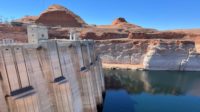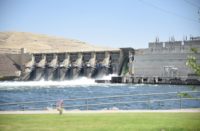Federal officials are preparing to help fund a slate of projects aimed to preserve the drought-stricken Colorado River system after reaching a tentative agreement with three states to reduce their use of river water.
The U.S. Dept. of the Interior Bureau of Reclamation opened a funding opportunity May 24 for long-term system efficiency improvement project proposals to conserve water for the lower Colorado River system and its users.
Proposals must result in measurable water savings in Lake Mead at the Arizona-Nevada border, or add new water to an applicant’s supply to allow a cut in use of river water, says the funding notice. They also must show that approaches are financially and technically viable to implement and for long-term operation, maintenance and replacement.
Selected projects would be funded with $4.6 billion set in last year’s Inflation Reduction Act for water management and conservation efforts in the Colorado River basin and other areas impacted by drought.
“The projects funded under the program will help increase water conservation, improve water efficiency, and prevent the system’s reservoirs from falling to critically low elevations, threatening water deliveries and hydropower production,” Reclamation Commissioner Camille Touton said in a statement.
Ongoing droughts in the western U.S. have caused record-low water levels reservoirs along the iver system, including in Lake Mead last summer and in Lake Powell on the Utah-Arizona line this year, bureau data show. The conditions have raised concerns that reservoirs levels could drop below the minimum needed to operate hydroelectric power plants at Glen Canyon and Hoover Dams.
Water Conservation Plans
Under terms of the consensus conservation proposal with Arizona, California and Nevada, lower basin states would cut river system water use by 3 million acre-ft through 2026, Interior announced. States will be compensated via the Inflation Reduction Act for up to 2.3 million acre-ft of conserved water. Officials did not specify the exact amount of compensation, but the Associated Press reported it at $1.2 billion.
Adel Hagekhalil, general manager of Los Angeles-based Metropolitan Water District of Southern California, said in a statement that the agreement would produce needed short-term stability for the river system. He also pointed to California’s wet winter in helping reduce its near-term risks.
The bureau also announced eight conservation agreements with water entities in the Phoenix and Tucson, Ariz., metro areas that would conserve up to 393,000 acre-ft of water through 2025 and provide $400 per acre-ft from their allotment that is not used.
“These locally led conservation agreements reflect our sustained progress in increasing water conservation across the West,” Deputy Interior Secretary Tommy Beaudreau said in a statement.
In addition to the $4.6 billion from IRA, the 2021 Infrastructure Investment and Jobs Act set $8.3 billion for the bureau to boost water infrastructure projects for drought resilience and access to clean water.
In April, officials announced funding for projects benefitting the Gila River Indian Community in Arizona, which also recently reached a conservation agreement. The community, which includes the Akimel O’odham (Pima) and Pee-Posh (Maricopa) tribes, will receive $50 million for conservation that bureau officials say will result in almost 2 ft of elevation in Lake Mead, plus up to 125,000 acre-ft of conservation in 2024 and 2025 for which the community would receive $50 million more for each additional year.
Interior Water Projects
Interior also is providing $83 million to the Gila River Indian Community to reclaim a 19-mile water pipeline to improve delivery of water for irrigation. Work on the project by contractor T&T Construction Inc. and designer Stantec began May 19, the Arizona Mirror reported.
The deartment is also providing $73 million for water delivery system infrastructure repairs, including to the Imperial Dam outside Yuma, Ariz., plus $71 million for 32 drought resilience projects in eight states.
Another $20 million is planned for small surface and groundwater storage projects in California and Utah, including an Imperial Valley, Calif., reservoir project and the first phase of one to build recharge basins, recovery wells and conveyance infrastructure in Kern County, Calif.
Twenty-one water recycling projects, most located in California, are set to receive another $281 million combined and increase annual water capacity by 127,000 acre-ft.






Post a comment to this article
Report Abusive Comment